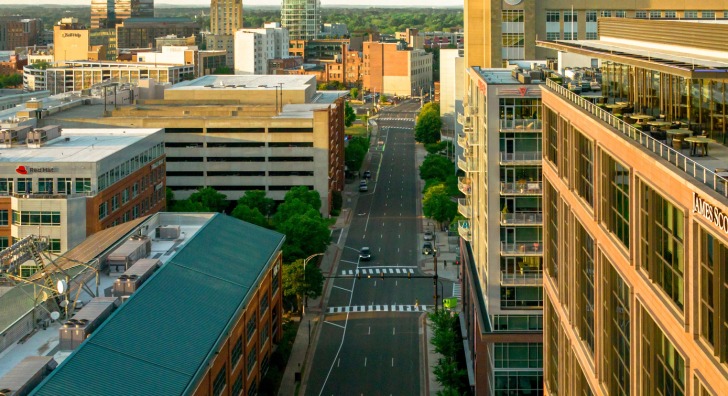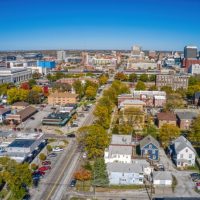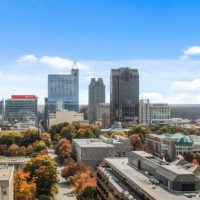Durham is part of the famed Research Triangle, making it a headquarters for a lot of tech companies, and research activity.
The area is relatively affluent as a result.
The cost of living is a little high, but income levels are above average as well.
There is a lot to like about Durham, and not many things to dislike.
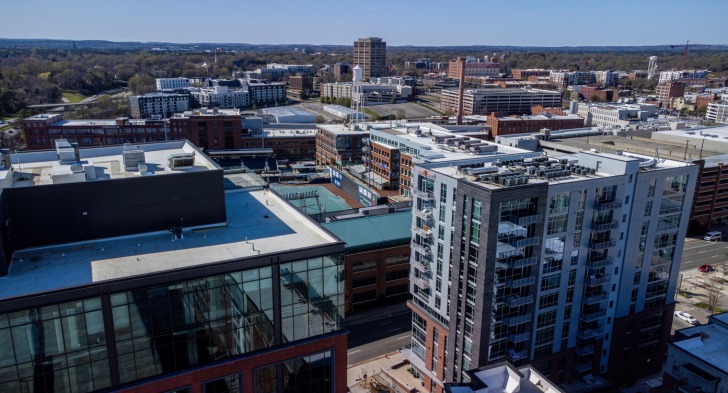
Contents
Pros of Living in Durham, N.C.
1. The Research Triangle
The research triangle includes the cities of Durham, Chapel Hill, and Raleigh.
It is home to major research universities like Duke, N.C. State, and the University of North Carolina.
The area is home to more than 300 companies, many involved in technology and research.
The Research Triangle Park is in the middle of it all and employs more than 60,000 in high-paying jobs.
You can easily get a good education and a good job in Durham.
2. Quality of Life
The research triangle creates a lot of good jobs, and that tends to raise the quality of life for everyone.
It is surrounded by major universities, and education opportunities are endless.
The weather is tolerable most of the time, and the cost of living is not terribly high.
There is a lot of interesting history to explore, and there are a lot of great natural areas to explore in the immediate area as well.
3. Great for Sports Fans
There are no professional sports teams, but there are a lot of college sports teams, especially related to basketball.
Duke, North Carolina, is almost always among the top basketball teams.
College football and women’s sports are also very popular in this area.
High school sports are also popular here, so you always have a chance to see some good sports around Durham.
4. Education
Durham is home to Duke University, one of the most respected schools in the nation.
There are about a dozen other major colleges within a very short distance of Durham.
The University of North Carolina is only eight miles from Duke University.
This trickles down to public education in grades K-12.
The city has highly-rated high schools and public education.
5. Trails
The American Tobacco Trail is on an old rail bed that once transported tobacco from Durham to Duncan N.C.
The trail goes for 22 miles through Durham, through several types of terrain, both city and country.
This is just the beginning.
There are lots of recreational trails in the Durham area of varying levels of difficulty.
Hiking, walking, running, cycling, and horseback riding, are just some of the activities you can easily do in Durham.
6. Thriving Arts Scene
There are dozens of small clubs or bars where you can catch live music of all kinds, as well as public performances all over town.
There are many street murals, as well as art galleries of all kinds of art.
It hosts the American Dance Festival, and the Full Frame Documentary Festival, which is a major film event.
Durham also is home to the largest surrealist art gallery in the world.
7. A Foodie Town
Durham has a reputation for having some of the best restaurants in the nation.
Southern Living Magazine called it the tastiest town in the South, beating out even New Orleans.
The reason perhaps is the wide variety of cuisines offered, which means there are not very many kinds of food not available in Durham.
The city has a lot of old restaurants that have been in the same family for generations, and use secret family recipes.
There are more than 130 restaurants in the downtown area.
8. Rich and Interesting History
Durham was once the tobacco capital of the world, and it was one of the major producers of textiles in America for a time.
The history of North Carolina goes way before the nation was founded, and that history lives here as well.
Durham was not started until the 1850s, but there is an interesting history from the foundation of the nation to now.
It was important in the civil rights movement.
Several buildings have been restored in downtown Durham, and there are several museums to see the history that lived in this area.
9. Low Unemployment
The unemployment rate in Durham is a consistent 2.9 percent.
It was 3.0 percent last year.
In general, this means almost everyone who wants a job has one.
The national rate is 3.9 percent and 3.4 percent at the state level.
Cons of Living in Durham, N.C.
1. Weather
Winters are mild and Spring is great, but Summer and Fall are not great.
Summers get hot and humid and do not cool down much at night.
Summers can be uncomfortable without air conditioning.
In late summer and fall, there are hurricanes.
Even a good distance from the coast, you will still get a lot of rainfall and have local flooding when a hurricane comes.
Hurricanes don’t come close every year, but when they do, they can be destructive.
2. Pollen
Allergy sufferers will suffer even more in this area.
There are the usual springtime allergies, and they come back in the fall and affect many people.
Pollen counts are reported in local weather forecasts because the levels are so high.
If you have mild allergies somewhere else and move here, you may find yourself with major symptoms.
3. Heavy Traffic
Durham is a good-sized town, and there are other cities in the immediate area.
There are a lot of commuters, and that means a lot of traffic congestion.
During rush hour especially, it can be difficult to get anywhere with your car.
Traffic can be heavy throughout the day as well.
On Game Day, traffic around Duke University is very heavy.
There are a lot of tourists too, so it may not lighten up a lot on weekends.
4. High Crime Rate
Durham has a surprisingly high crime rate.
Violent crime is at 7.58 per 1,000 people, almost twice the national rate of 4.0.
The state average is 4.3.
Robbery is the most common crime, nearly three times the national average, and murder is twice the national rate.
Property crime is also high at 35 per 1,000, while the national average is 19.
There are some very safe areas in Durham, but the crime rate means there are some very bad areas as well.
5. Cost of Living
The cost of living in Durham is just barely above the national average, meaning there are lots of places more expensive.
Charlotte, NC is more expensive. Even so, it is eight percent above the state average.
Housing is the major culprit, at nine percent above the national average, and 30 percent above the state average.
Utilities and general services are lower than the state average.
6. No Beaches or Mountains
There are nice places to be outdoors in the Durham area, but the scenery is not above average.
It is two hours to beaches to the east, or two hours to the mountains to the west.
It’s too far for a day trip to either one.
It is also close enough to be tempting, which can make it worse.
The lack of either beaches or mountains within easy driving distance would be a negative for a lot of people.
7. Entertainment Costs
Durham has pushed its tourism business in recent years, which makes for a more crowded town and pushes costs up.
Concerts, theaters, and restaurants all cost more because of tourism.
Groceries may also be higher when it comes to specialty items.
Tourism generally benefits the local economy and provides jobs, but it also raises costs for overall entertainment.
8. Double-Edged Job Market
If you have the training and skills, it is easy to find a good-paying job in the Durham area.
If you do not have training and skills, you may find it difficult.
The area is heavy on technology, healthcare, and research.
The skill areas are rather narrow, so if you do not have specific training for specific needs, you may not have as easy of a time finding a good job.
9. High Poverty Rate
According to U.S. Government figures 13.4 percent of the people of Durham live under the poverty level.
The national average is around 11 percent.
Per capita, income is $39,000, above the national average of $37,000.
While there are a lot of good jobs, there is a lot of poverty as well.
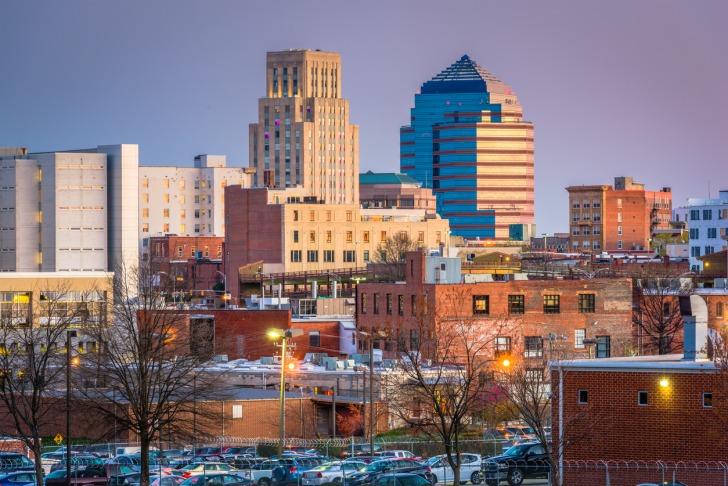
Pros and Cons of Living in Durham, NC – Summary Table
| Pros of Living in Durham, N.C. | Cons of Living in Durham, N.C. |
|---|---|
| 1. The Research Triangle | 1. Weather |
| 2. Quality of Life | 2. Pollen |
| 3. Great for Sports Fans | 3. Heavy Traffic |
| 4. Education | 4. High Crime Rate |
| 5. Trails | 5. Cost of Living |
| 6. Thriving Arts Scene | 6. No Beaches or Mountains |
| 7. A Foodie Town | 7. Entertainment Costs |
| 8. Rich and Interesting History | 8. Double-Edged Job Market |
| 9. Low Unemployment | 9. High Poverty Rate |
Durham Safety Overview
READ THE FULL REPORT: Durham Safety Review
Safety Index: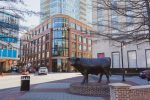
- OVERALL RISK: LOW
- TRANSPORT & TAXIS RISK: LOW
- PICKPOCKETS RISK: LOW
- NATURAL DISASTERS RISK: LOW
- MUGGING RISK: LOW
- TERRORISM RISK: LOW
- SCAMS RISK: LOW
- WOMEN TRAVELERS RISK: LOW
Frequently Asked Questions
How did Durham get started?
It is not as old as many North Carolina cities.
It was incorporated in 1869 and was developed as part of the expanding railroad.
A man named Durham gave the railroad company four acres to build a station and a town developed around there.
The town was named Durhamville originally, in his honor.
Nearby Raleigh, for example, was founded in 1792.
Why was Durham called the Bull City?
In the late 1800s, the Blackwell Tobacco Company named its tobacco products “Bull Durham,” which became a very popular brand.
People started calling it Bull City as a result.
Is Durham a growing city?
The growth of the Research Triangle, as well as Duke University, has kept the city of Durham growing over the years.
Since 1970 the city has grown by about 25 percent each decade
In 1960 there were 78,000 people, and today there are 291,000.
How close are the three major state universities to Durham?
Duke University is in Durham, and the other two major state universities are very close.
The University of North Carolina is in Chapel Hill, just nine miles away.
North Carolina State is in Raleigh, and that is 22 miles away.
There are about 85,000 students at these three universities.
What was a significant development in black history in Durham?
After the Civil War, former slaves created their own business district that was called “Black Wall Street” for a time.
Through these efforts, a National Religious Training School was founded, and that later became North Carolina Central University.
This was the first state-supported liberal arts historically black college in America.
What is the story of tobacco in Durham?
Durham was one of the largest tobacco centers in the world in the late 1800s.
The Supreme Court forced the dissolution of a merger that violated the rules against monopolies in 1911.
That resulted in four new companies being formed, and they were still the four largest tobacco companies in America.
The area’s huge tobacco production, and the location of railroads, made it a natural center for tobacco production.
